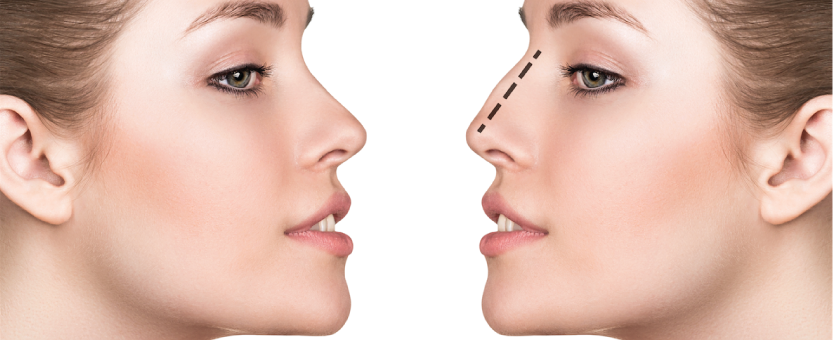What surgical rhinoplasty can treat
• Nose size in relation to facial balance
• Nose width at the bridge or in the size and position of the nostrils
• Nose profile with visible humps or depressions on the bridge
• Nasal tip that is enlarged or bulbous, drooping, upturned or hooked
• Nostrils that are large, wide or upturned
• Nasal asymmetry
Everyone's face is asymmetric to some degree. Results may not be completely symmetric, although the goal is to create facial balance and correct proportion.
Rhinoplasty to correct a deviated septum
Nose surgery that's done to improve an obstructed airway requires careful evaluation of the nasal structure as it relates to airflow and breathing.
Correction of a deviated septum, one of the most common causes of breathing impairment, is achieved by adjusting the nasal structure to produce better alignment.
Rhinoplasty cost
Rhinoplasty surgery costs can vary widely. The average fee referenced does not include anesthesia, operating room facilities or other related expenses.
A surgeon's fee will be based on his or her experience and geographic office location.
Rhinoplasty costs may include:
• Anesthesia fees
• Hospital or surgical facility costs
• Medical tests
• Post-surgery garments
• Prescriptions for medication
• Surgeon's fee
remember that the surgeon's experience and your comfort with him or her are just as important as the final cost of the surgery.
Rhinoplasty candidates
You may be a good candidate for rhinoplasty if:
• Your facial growth is complete
• You are physically healthy
• You don't smoke
• You have a positive outlook and realistic goals in mind for the improvement of your appearance
Rhinoplasty recovery
During your rhinoplasty recovery, a splint and/or packing may be placed inside your nose and a splint or bandages placed on the outside to support and protect the new structures during initial healing.
While initial swelling subsides within a few weeks, it may take up to a year for your new nasal contour to fully refine. During this time you may notice gradual changes in the appearance of your nose as it refines to a more permanent outcome.
Swelling may come and go and worsen in the morning during the first year following your rhinoplasty surgery.
You will be given specific instructions that may include:
• How to care for the surgical site
• Medications to apply or take orally to aid healing and reduce the potential for infection
• Specific concerns to look for at the surgical site or in your general health
• When to follow up with your plastic surgeon.
Be sure to ask your rhinoplasty surgeon specific questions about what you can expect during your individual recovery period:
• Where will I be taken after my surgery is complete?
• What medication will I be given or prescribed after surgery?
• Will I have dressings/bandages after surgery?
• When will they be removed?
• Are stitches removed? When?
• When can I resume normal activity and exercise?
• When do I return for follow-up care?
Rhinoplasty results
The results of rhinoplasty surgery will be long-lasting.
As your body ages, it is natural to have some gradual changes to your face including your nose. But most of your improvement should be relatively permanent.
A healthy lifestyle and life-long sun protection will help extend the results of your new appearance.
Rhinoplasty risks and safety
The decision to have surgery is extremely personal. You will have to decide if the benefits will achieve your goals and if the risks and potential complications of rhinoplasty are acceptable.
You will be asked to sign consent forms to ensure that you fully understand the procedure and any risks or potential complications.
Rhinoplasty surgery risks include:
• Anesthesia risks
• Infection
• Poor wound healing or scarring
• Change in skin sensation (numbness or pain)
• Nasal septal perforation (a hole in the nasal septum) is rare. Additional surgical treatment may be necessary to repair the septum but it may be impossible to correct this complication
• Difficulty breathing
• Unsatisfactory nasal appearance
• Skin discoloration and swelling
• Possibility of revisional surgery
These risks and others will be fully discussed prior to your consent.
Your rhinoplasty consultation
During your rhinoplasty consultation be prepared to discuss:
• Your surgical goals, with regard to both appearance and breathing
• Medical conditions, drug allergies and previous medical treatments
• Current medications, vitamins, herbal supplements, alcohol, tobacco and drug use
• Previous surgeries
Your rhinoplasty surgeon may also:
• Evaluate your general health status and any pre-existing health conditions or risk factors
• The options available to you for nose reshaping
• Examine and measure your face
• Take photographs
• Discuss your nose surgery options
• Recommend a course of treatment
• Discuss likely outcomes of a nose surgery and any risks or potential complications
The consultation is the time to ask your surgeon questions. To help, we have prepared a checklist of questions to ask surgeon that you can take with you to your consultation.
It's very important to understand all aspects of your rhinoplasty procedure. It's natural to feel some anxiety, whether it's excitement for your anticipated new look or a bit of preoperative stress. Don't be shy about discussing these feelings with your rhinoplasty surgeon.
Preparing for rhinoplasty surgery
In preparing for rhinoplasty surgery, you may be asked to:
• Get a lab test
• Take certain medications or adjust your current medications
• Stop smoking
• Avoid taking aspirin, anti-inflammatory drugs and herbal supplements as they can increase bleeding
Your rhinoplasty surgeon will also discuss where your procedure will be performed.
Rhinoplasty may be performed in an accredited office-based surgical facility, a licensed ambulatory surgical center or a hospital. Be sure to arrange for someone to drive you to and from surgery and to stay with you for at least the first night following surgery.
Rhinoplasty
- Home
- Rhinoplasty




